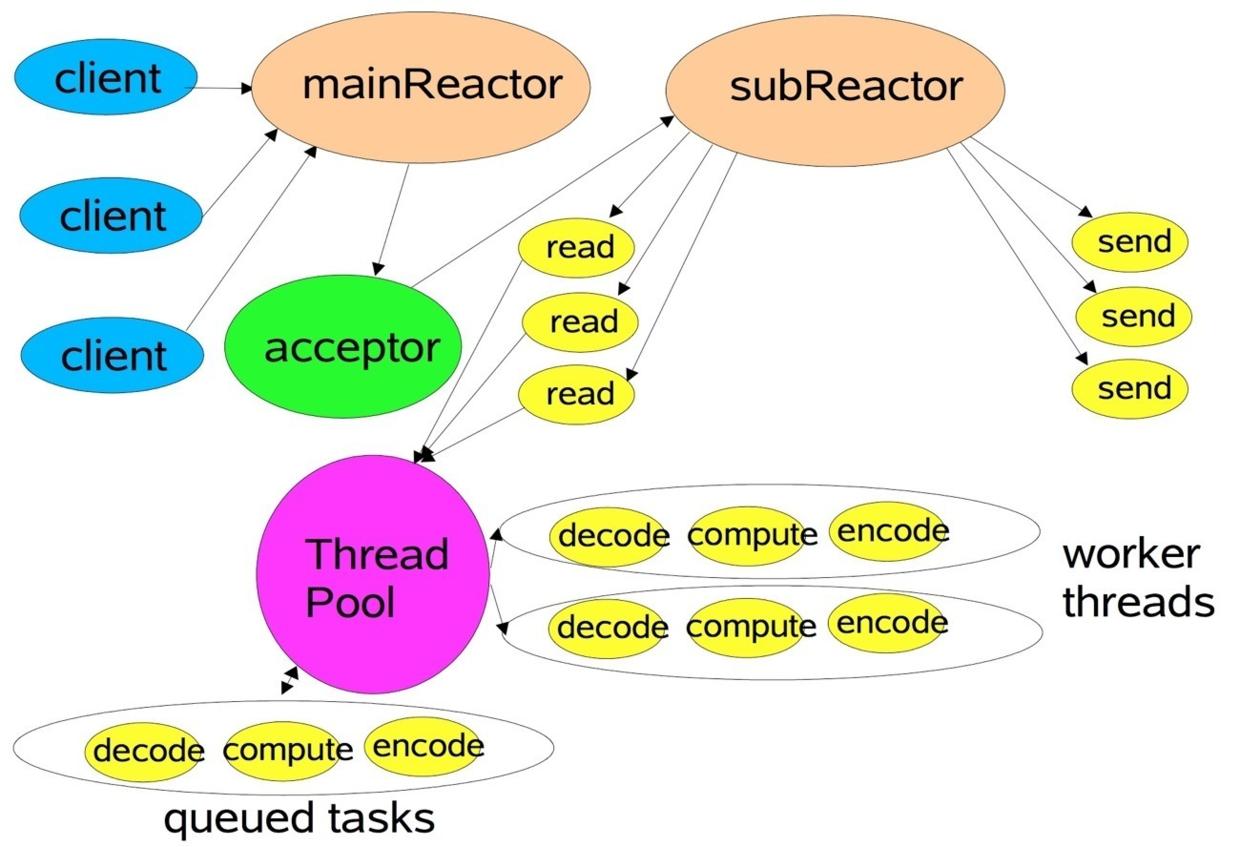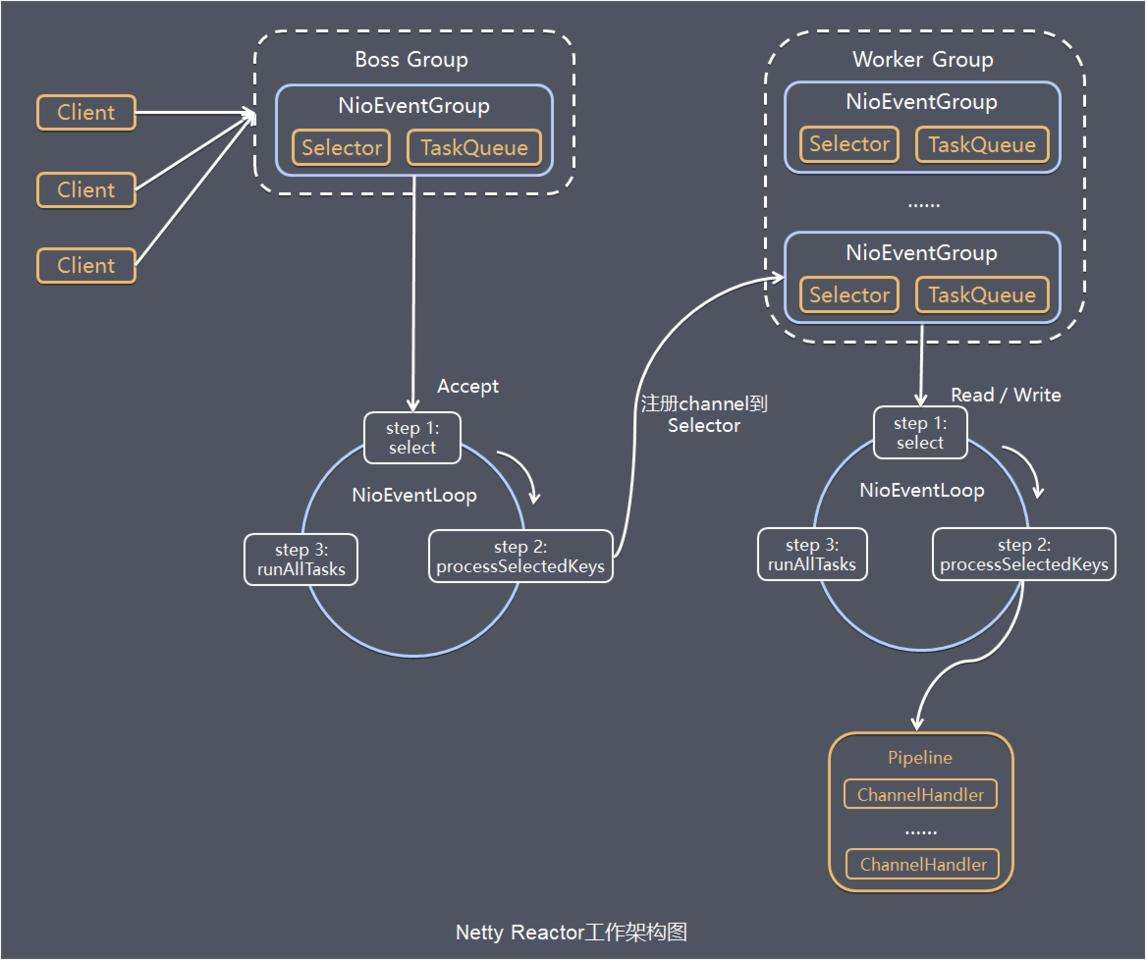简介
对比于原生NIO
Java原生包
- NIO的类库和API繁杂,使用麻烦,你需要熟练掌握Selector、ServerSocketChannel、SocketChannel、ByteBuffer等
- 需要具备其它的额外技能做铺垫,例如熟悉Java多线程编程,因为NIO编程涉及到Reactor模式,你必须对多线程和网路编程非常熟悉,才能编写出高质量的NIO程序
- 可靠性,开发工作量和难度都非常大。例如客户端面临断连重连、网络闪断、半包读写、失败缓存、网络拥塞和异常码流的处理等等,NIO编程的特点是功能开发相对容易,但是可靠性能力补齐工作量和难度都非常大
- JDK NIO的BUG,例如臭名昭著的epoll bug,它会导致Selector空轮询,最终导致CPU 100%。
Netty
Netty的对JDK自带的NIO的API进行封装,解决上述问题,主要特点有:
- 设计优雅 适用于各种传输类型的统一API - 阻塞和非阻塞Socket 基于灵活且可扩展的事件模型,可以清晰地分离关注点 高度可定制的线程模型 - 单线程,一个或多个线程池 真正的无连接数据报套接字支持(自3.1起)
- 使用方便 详细记录的Javadoc,用户指南和示例 没有其他依赖项,JDK 5(Netty 3.x)或6(Netty 4.x)就足够了
- 高性能 吞吐量更高,延迟更低 减少资源消耗 最小化不必要的内存复制
安全 完整的SSL / TLS和StartTLS支持 - 社区活跃,不断更新 社区活跃,版本迭代周期短,发现的BUG可以被及时修复,同时,更多的新功能会被加入
模型
概述
Netty主要基于主从Reactors多线程模型,其中主从Reactor多线程模型有多个Reactor:MainReactor和SubReactor:

MainReactor负责客户端的连接请求,并将请求转交给SubReactor
SubReactor负责相应通道的IO读写请求;
非IO请求(具体逻辑处理)的任务则会直接写入队列,等待worker threads进行处理.
核心概念
1、bootstrap、serverBootstrap:bootstrap的意思是引导,其主要作用是配置整个netty程序,将各个组件整合起来。serverBootstrap是服务器端的引导类。bootstrap用于连接远程主机它有一个EventLoopGroup ;serverBootstrap用于监听本地端口有两个EventLoopGroup。
2、eventLoop:eventLoop维护了一个线程和任务队列,支持异步提交执行任务。
3、eventLoopGroup:eventLoopGroup 主要是管理eventLoop的生命周期,可以将其看作是一个线程池,其内部维护了一组eventLoop,每个eventLoop对应处理多个Channel,而一个Channel只能对应一个eventLoop。
4、channelPipeLine:是一个包含channelHandler的list,用来设置channelHandler的执行顺序。
5、Channel:Channel代表一个实体(如一个硬件设备、一个文件、一个网络套接字或者一个能够执行一个或者多个不同的IO操作的程序组件)的开放链接,如读操作和写操作。
6、Futrue、ChannelFuture :Future提供了另一种在操作完成时通知应用程序的方式。这个对象可以看作是一个异步操作结果的占位符;它将在未来的某个时刻完成,并提供对其结果的访问。netty的每一个出站操作都会返回一个ChannelFuture。future上面可以注册一个监听器,当对应的事件发生后会出发该监听器。
7、ChannelInitializer:它是一个特殊的ChannelInboundHandler,当channel注册到eventLoop上面时,对channel进行初始化
8、ChannelHandler:用来处理业务逻辑的代码,ChannelHandler是一个父接口,ChannelnboundHandler和ChannelOutboundHandler都继承了该接口,它们分别用来处理入站和出站。
9、ChannelHandlerContext:允许与其关联的ChannelHandler与它相关联的ChannlePipeline和其它ChannelHandler来进行交互。它可以通知相同ChannelPipeline中的下一个ChannelHandler,也可以对其所属的ChannelPipeline进行动态修改。
图解

- Netty抽象出两组线程池: 1. BossGroup负责接收客户端连接; 2. WorkerGroup负责网络Channel读写.
- 以上两Group都是NioEventLoopGroup, 主要管理eventLoop的生命周期,可以理解为一个线程池,内部维护了一组线程,每个线程(NioEventLoop)负责处理多个Channel上的事件,而一个Channel只对应于一个线程。NioEventLoopGroup可以有多个线程.
- NioEventLoop维护了一个线程和任务队列,支持异步提交执行任务,线程启动时会调用NioEventLoop的run方法,执行I/O任务和非I/O任务, 每个都有一个selector.
- Selector: Netty基于Selector对象实现I/O多路复用,通过 Selector, 一个线程可以监听多个连接的Channel事件, 当向一个Selector中注册Channel 后,Selector 内部的机制就可以自动不断地查询(select) 这些注册的Channel是否有已就绪的I/O事件(例如可读, 可写, 网络连接完成等),这样程序就可以很简单地使用一个线程高效地管理多个 Channel。
- ChannelPipline: 保存ChannelHandler的List,用于处理或拦截Channel的入站事件和出站操作。 ChannelPipeline实现了一种高级形式的拦截过滤器模式,使用户可以完全控制事件的处理方式,以及Channel中各个的ChannelHandler如何相互交互。
Boss Group下的NioEventGroup执行:
- 轮询accept事件;
- 监听到accept, 与client建立连接, 生成NioSocketChannel, 并将其注册到某个worker的NioEventLoop上的selector;
- 处理任务, runAllTasks.
Worker Group下的NioEventGroup执行:
- 轮询read, write事件;
- 监听到I/O, 在NioSocketChannel上进行处理;
- 处理任务, runAllTasks.
一些自带的解码/编码器
以下东西用在给pipeline里通过addLast()方法增加handler:
-
DelimiterBasedFrameDecoder :分隔符解码器,以设定的符号作为消息的结束解决粘包问题
-
FixedLengthFrameDecoder :定长解码器,作用于定长的消息
-
LineBasedFrameDecoder :按照每一行进行分割,也就是特殊的分隔符解码器,它的分割符为\n或者\r\n。
-
LengthFieldBasedFrameDecoder :通过消息中设置的长度字段来进行粘包处理。该解码器总共有5个参数
-
LengthFieldBasedFrameDecoder(int maxFrameLength, 单个包的最大大小
int lengthFieldOffset, 定义长度的字段的相对包开始的偏移量
int lengthFieldLength, 定义长度字段所占字节数
int lengthAdjustment, lengthAdjustment = 数据长度字段之后剩下包的字节数 - 数据长度取值(也就是长度字段之后的所有非数据的其他信息)
int initialBytesToStrip) 从包头开始,要忽略的字节数
-
HttpRequestDecoder :将字节解码为HttpRequest、HttpContent和LastHttpContent消息
-
HttpResponseDecoder :将字节解码为HttpResponse、HttpContent和LastHttpContent消息
-
ReplayingDecoder :一个特殊的ByteToMessageDecoder ,可以在阻塞的i/o模式下实现非阻塞的解码。 ReplayingDecoder 和ByteToMessageDecoder 最大的不同就是ReplayingDecoder 允许你实现decode()和decodeLast()就像所有的字节已经接收到一样,不需要判断可用的字节
-
Base64Decoder :Base64编码器
-
StringDecoder :将接收到的ByteBuf转化为String
-
ByteArrayDecoder :将接收到的ByteBuf转化为byte 数组
-
DatagramPacketDecoder :运用指定解码器来对接收到的DatagramPacket进行解码
-
MsgpackDecoder :用于Msgpack序列化的解码器
-
ProtobufDecoder :用于Protobuf协议传输的解码器
-
HttpObjectAggregator :将http消息的多个部分聚合起来形成一个FullHttpRequest或者FullHttpResponse消息。
-
LengthFieldPrepender :将消息的长度添加到消息的前端的编码器,一般是和LengthFieldBasedFrameDecoder搭配使用
-
HttpServerCodec :相当于HttpRequestDecoder和HttpResponseEncoder
-
HttpClientCodec :相当于HttpRequestEncoder和HttpResponseDecoder
-
ChunkedWriteHandler :在进行大文件传输的时候,一次将文件的全部内容映射到内存中,很有可能导致内存溢出,ChunkedWriteHandler可以解决大文件或者码流传输过程中可能发生的内存溢出问题
代码示例
服务端
package org.example.netty.simple;
import io.netty.bootstrap.ServerBootstrap;
import io.netty.channel.ChannelFuture;
import io.netty.channel.ChannelInitializer;
import io.netty.channel.ChannelOption;
import io.netty.channel.EventLoopGroup;
import io.netty.channel.nio.NioEventLoopGroup;
import io.netty.channel.socket.SocketChannel;
import io.netty.channel.socket.nio.NioServerSocketChannel;
import io.netty.channel.socket.nio.NioSocketChannel;
/**
* @author 996Worker
* @description
* @create 2022-02-21 13:18
*/
public class NettyServer {
public static void main(String[] args) throws InterruptedException {
// create BossGroup and WorkerGroup
EventLoopGroup bossGroup = new NioEventLoopGroup();
EventLoopGroup workerGroup = new NioEventLoopGroup();
try {
// configuration
ServerBootstrap boot = new ServerBootstrap();
boot.group(bossGroup, workerGroup)
.channel(NioServerSocketChannel.class) // 服务端channel实现
.option(ChannelOption.SO_BACKLOG, 128) // thread queue size
.childOption(ChannelOption.SO_KEEPALIVE, true) // keep connection alive
.childHandler(new ChannelInitializer<SocketChannel>() {
// set handler for pipeline
@Override
protected void initChannel(SocketChannel socketChannel) throws Exception {
socketChannel.pipeline().addLast(new MyNettyServerHandler());
}
});
System.out.println("Server is ready");
// set port
// 绑定一个端口并同步, 生成一个ChannelFuture对象
ChannelFuture sync = boot.bind(6668).sync();
System.out.println("server started at 6668");
// 对关闭通道的监听
sync.channel().closeFuture().sync();
} finally {
bossGroup.shutdownGracefully();
workerGroup.shutdownGracefully();
}
}
}
对pipeline需要的handler的定义:
package org.example.netty.simple;
import io.netty.buffer.ByteBuf;
import io.netty.buffer.Unpooled;
import io.netty.channel.ChannelHandlerContext;
import io.netty.channel.ChannelInboundHandlerAdapter;
import io.netty.util.CharsetUtil;
/**
* @author 996Worker
* @description
* @create 2022-02-21 13:35
*/
// 入站请求的handler
public class MyNettyServerHandler extends ChannelInboundHandlerAdapter {
// 读取数据
// ctx: 含有pipeLine, channel
// msg: 客户端发送的数据
@Override
public void channelRead(ChannelHandlerContext ctx, Object msg) throws Exception {
// msg to byteBuffer
ByteBuf buf = (ByteBuf) msg;
System.out.println("Received msg from: " + ctx.channel().remoteAddress());
System.out.println("Client says: " + buf.toString(CharsetUtil.UTF_8));
}
// after数据读完
@Override
public void channelReadComplete(ChannelHandlerContext ctx) throws Exception {
ctx.writeAndFlush(Unpooled.copiedBuffer("hello, I've received your message.", CharsetUtil.UTF_8));
}
// 处理异常
@Override
public void exceptionCaught(ChannelHandlerContext ctx, Throwable cause) throws Exception {
System.out.println("An exception occurred, close the chan.");
ctx.channel().close();
}
}
客户端
package org.example.netty.simple;
import io.netty.bootstrap.Bootstrap;
import io.netty.channel.ChannelFuture;
import io.netty.channel.ChannelInitializer;
import io.netty.channel.EventLoopGroup;
import io.netty.channel.nio.NioEventLoopGroup;
import io.netty.channel.socket.SocketChannel;
import io.netty.channel.socket.nio.NioSocketChannel;
/**
* @author 996Worker
* @description
* @create 2022-02-21 15:52
*/
public class NettyClient {
public static void main(String[] args) throws InterruptedException {
// 客户端需要一个时间循环组
EventLoopGroup eventExecutors = new NioEventLoopGroup();
// 客户端使用Bootstrap启动对象, 不是ServerBootStrap
Bootstrap bootstrap = new Bootstrap();
try {
// 设置相关参数
bootstrap.group(eventExecutors)
.channel(NioSocketChannel.class) // 客户端Channel实现
.handler(new ChannelInitializer<SocketChannel>() {
@Override
protected void initChannel(SocketChannel socketChannel) throws Exception {
socketChannel.pipeline().addLast(new MyNettyClientHandler()); // 定义handler逻辑
}
});
System.out.println("客户端Ok");
ChannelFuture channelFuture = bootstrap.connect("127.0.0.1", 6668).sync();
channelFuture.channel().closeFuture().sync();
} finally {
eventExecutors.shutdownGracefully();
}
}
}
对所需handler的定义:
package org.example.netty.simple;
import io.netty.buffer.ByteBuf;
import io.netty.buffer.Unpooled;
import io.netty.channel.ChannelHandlerContext;
import io.netty.channel.ChannelInboundHandlerAdapter;
import io.netty.util.CharsetUtil;
/**
* @author 996Worker
* @description
* @create 2022-02-21 16:02
*/
public class MyNettyClientHandler extends ChannelInboundHandlerAdapter {
// 当CHnnel就绪就会触发的钩子函数
@Override
public void channelActive(ChannelHandlerContext ctx) throws Exception {
System.out.println("client: " + ctx);
ctx.writeAndFlush(Unpooled.copiedBuffer("hello, server!", CharsetUtil.UTF_8));
}
// 当Channel能读时触发
@Override
public void channelRead(ChannelHandlerContext ctx, Object msg) throws Exception {
ByteBuf buf = (ByteBuf) msg;
System.out.println("Server says: " + buf.toString(CharsetUtil.UTF_8));
System.out.println("Server address: " + ctx.channel().remoteAddress());
}
@Override
public void exceptionCaught(ChannelHandlerContext ctx, Throwable cause) throws Exception {
System.out.println("An exception occurred in client, close the chan.");
ctx.channel().close();
}
}
